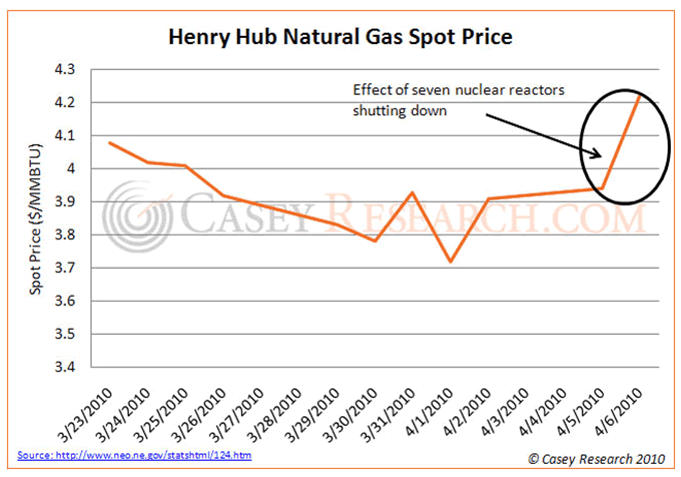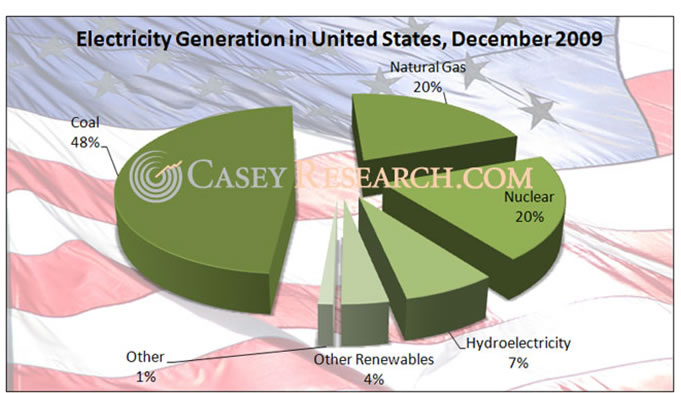Electricity Generation Going Nuclear, Obama’s Green Machine Is Ready to Go
Commodities / Renewable Energy Apr 14, 2010 - 01:42 AM GMTBy: Casey_Research
 Marin Katusa Casey’s Energy Opportunities writes: Over the Easter weekend, seven nuclear reactors throughout the United States stopped operations, and natural gas prices skyrocketed by over 20%. And this was when most of the country was enjoying mild weather and businesses were shut for the long weekend.
Marin Katusa Casey’s Energy Opportunities writes: Over the Easter weekend, seven nuclear reactors throughout the United States stopped operations, and natural gas prices skyrocketed by over 20%. And this was when most of the country was enjoying mild weather and businesses were shut for the long weekend.

Now traders are out in force looking for the cheapest possible power ahead of rising demand, and the power markets are heading one way: up.
No Homer Simpsons Allowed Here!
It is unfortunate that nuclear power plants are still linked in our minds to the Three Mile Island and Chernobyl disasters. While these were some truly horrific events, we’re failing to realize one very important fact: we’ve learnt from our mistakes. The next generation of nuclear plants are better designed and more safety measures have been put into place than what was there in the plants from the 1960s and 1970s. There is always some operational risk, but that is present in every power plant, be it coal, natural gas, geothermal, or nuclear.
Currently, the United States houses roughly 24% of the world’s nuclear reactors, and they account for about 20% of the power generated in the country. That’s one in every five homes being powered by nuclear energy. This number is a lot higher for some states, with New Jersey getting almost more than 50% of its power from nuclear energy. With renewed interest in nuclear power in the U.S. and President Obama guaranteeing loans for two new reactors this February, it’s pretty clear that the nuclear share in the energy pie is set to increase.

It’s Clean, It’s Green, It’s the New Obama Nuclear Machine
Though they vary in design, nuclear reactors operate on the same basic principle: the energy released by nuclear fission heats water to produce steam, which turns the turbines that generate electricity. The silver lining: no fossil fuels are burnt at any stage, so almost no greenhouse gases are produced. They are, however, expensive to build and it can take years. But once in operation, fuel costs are very low, which translates to low maintenance costs, and each plant can easily operate for up to 60 years. Running at around 90% capacity, nuclear power plants are workhorses that shut down only once every 18 months for refueling and maintenance.
The fact that they emit almost no greenhouse gases also makes nuclear power plants safe from the threat of potential emissions caps. Once these are introduced, and they are certainly going to be introduced, the costs of producing electricity at coal and natural gas-fired plants will noticeably escalate. In fact, the high energy yield of nuclear fuels, the carbon dioxide emitted during the mining, enriching, fabrication, and transportation of uranium is very small compared to the carbon dioxide emitted by fossil fuels.
Do You Like a 1,500% Return on Your Stocks? Our Subscribers Do.
The push to restart the uranium mining industry started up in 2001 and by 2006, America’s yellowcake production had increased by 70%. The Casey Research team was out scouting the market, and we knew which junior uranium mining company was going to explode. On our recommendation, our subscribers saw their stocks that they bought at under US$0.25 shoot up to over US$4 per share in less than a year.
Today, America’s nuclear industry is ready to expand again and has all the political and economic support necessary to do so. Consuming almost 30% of the world’s uranium, America’s uranium mining industry is looking to jumpstart itself again and at Casey Research, we know all the inside details. Click here for your free trial today and find out who will win the prize and who will miss out.
© 2010 Copyright Casey Research - All Rights Reserved
Disclaimer: The above is a matter of opinion provided for general information purposes only and is not intended as investment advice. Information and analysis above are derived from sources and utilising methods believed to be reliable, but we cannot accept responsibility for any losses you may incur as a result of this analysis. Individuals should consult with their personal financial advisors.
© 2005-2022 http://www.MarketOracle.co.uk - The Market Oracle is a FREE Daily Financial Markets Analysis & Forecasting online publication.



